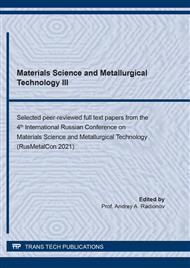[1]
V.Yu. Filin, Quality control of steels for large-sized welded structures of the arctic shelf: Application of Russian and foreign requirements, Inorganic Materials: Applied Research. 10(6) (2019) 1492-1503.
DOI: 10.1134/s207511331906008x
Google Scholar
[2]
T. Meshii, K. Lu, Y. Fujiwara, Extended investigation of the test specimen thickness (TST) effect on the fracture toughness (Jc) of a material in the ductile-to-brittle transition temperature region as a difference in the crack tip constraint — What is the loss of constraint in the TST effects on Jc?. Engineering Fracture Mechanics. 135 (2015) 286-294.
DOI: 10.1016/j.engfracmech.2014.07.025
Google Scholar
[3]
A.A. Lavrentev, Analysis of scale effect in fracture toughness tests of high-strength shipbuilding steels, in: N.A. Makhutov (Eds.), Proceedings of the V All-Russian conference Safety and survivability of technical systems, Krasnoyarsk. 2 (2015) 25-30.
Google Scholar
[4]
B.I. Berezhko, N,G, Bikovsky, M.I. Olenin, N.V. et al., Cold resistance of metallurgical semiproducts (plates and forgings) made of low-carbon silicon-manganese steels, Voprosy Materialovedeniya. 3 (2007) 43-49.
Google Scholar
[5]
M. Hauge, Arctic offshore materials and platform winterization, in: Proceedings of the Twenty-second International Offshore and Polar Engineering Conference, Rhodes, Greece, (2012).
Google Scholar
[6]
A.M. Horn, M. Hauge, Material challenges for Arctic offshore applications, a reliability study of fracture of a welded steel plate based on material toughness data at -60°C, in: Proceedings of the Twenty-first International Offshore and Polar Engineering Conference, Hawaii, USA, (2011).
Google Scholar
[7]
S.A. Golosienko, A.V. Ilyin, A.A. Lavrentiev, V.S. Mikhailov, G.D. Motovilina, S.N. Petrov, K.E. Sadkin, Cleavage fracture resistance of high-strength medium-alloyed steel and its relation to structural state parameters, Voprosy Materialovedeniya. 3 (2019) 128-145.
DOI: 10.22349/1994-6716-2019-99-3-128-147
Google Scholar
[8]
Yu.G. Matvienko, Models and criteria of fracture mechanics, Fizmatlit, Moscow, (2006).
Google Scholar
[9]
Z.Z. Du, J.W. Hancock, The effect of non-singular stresses on crack-tip constraint, J. Mech. Phys. Solids 39 (1991) 55-67.
Google Scholar
[10]
ISO 12135-2016 Metallic materials — Unified method of test for the determination of quasistatic fracture toughness. Second Edition. ISO, (2016).
DOI: 10.3403/30394398u
Google Scholar
[11]
ISO 15653-2018 Metallic materials — Method of test for the determination of quasistatic fracture toughness of welds. Second edition. ISO, (2018).
DOI: 10.3403/30157169u
Google Scholar
[12]
K.E. Sadkin, V.Yu. Filin, A.V. Mizetsky, E.D. Nazarova, FEM assessment of local side compression technique efficiency as applicable for notched prismatic specimens, Voprosy Materialovedeniya. 4 (2020) 182-191.
DOI: 10.22349/1994-6716-2020-104-4-182-191
Google Scholar
[13]
V. Yu. Filin, Development of the Criteria for Fracture Toughness and Cold Resistance of Materials of Welded Structures of the Offshore Shelf Based on Fracture Mechanics, Thesis of the dissertation for the degree of Doctor of Technical Sciences, CRISM Prometey, St. Petersburg, (2019).
Google Scholar
[14]
M.G. Dawes, Fatigue precracking weldment fracture mechanics specimens, Metal Construction and British Welding Journal. (1971) 61-65.
Google Scholar
[15]
A.A. Steffan, On the Effect of R-ratio and Kfmax on Fracture Toughness Measurement, Fatigue Crack Propagation and Fatigue Closure, Dissertation, Southern Methodist University, Texas, USA, (1987).
Google Scholar


